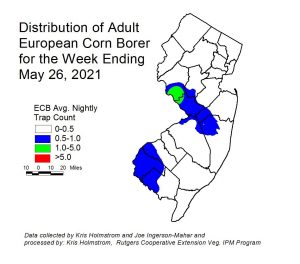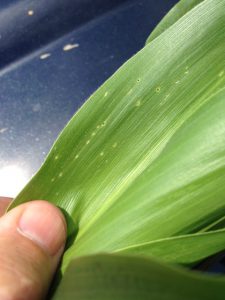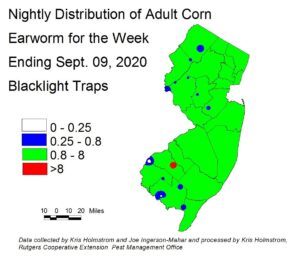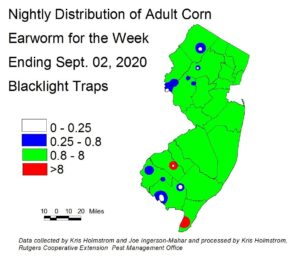Sweet Corn
European corn borer (ECB) moths are now being captured in parts of the state. As yet, numbers are low, and the next 7-10 days will likely tell whether this flight will be of any significant size. Current “hot spots” are around Salem County and southern Hunterdon into Mercer and Ocean counties (see map at right). Whorl corn is the primary target for egg laying, but as yet, scouts have reported no signs of feeding injury. We expect to encounter feeding over the next week. .
tell whether this flight will be of any significant size. Current “hot spots” are around Salem County and southern Hunterdon into Mercer and Ocean counties (see map at right). Whorl corn is the primary target for egg laying, but as yet, scouts have reported no signs of feeding injury. We expect to encounter feeding over the next week. .
 Look for the characteristic “shot-hole” type of feeding (photo below at right) and consider treating when infested plants exceed 12% in a 50 plant sample. As plantings proceed to the pre-tassel stage, ECB larvae may be found in emerging tassels (see photo at left). It is a good idea to treat individual plantings as they move into the full tassel/first silk stage one time. This eliminates any ECB larvae that have emerged with the tassels as they begin to move down the stalk to re-enter near developing ears.
Look for the characteristic “shot-hole” type of feeding (photo below at right) and consider treating when infested plants exceed 12% in a 50 plant sample. As plantings proceed to the pre-tassel stage, ECB larvae may be found in emerging tassels (see photo at left). It is a good idea to treat individual plantings as they move into the full tassel/first silk stage one time. This eliminates any ECB larvae that have emerged with the tassels as they begin to move down the stalk to re-enter near developing ears.
Useful insecticides for this particular application include synthetic  pyrethroids (IRAC Grp 3), spinosyns (including OMRI approved Entrust) IRAC Grp 5), and diamides such as Coragen or Vantacor (IRAC Grp 28) or materials such as Besiege which include the active ingredient in Coragen. Synthetic pyrethroids alone should NOT be used for corn earworm (CEW) protection on silking corn. Control with these materials is very inconsistent.
pyrethroids (IRAC Grp 3), spinosyns (including OMRI approved Entrust) IRAC Grp 5), and diamides such as Coragen or Vantacor (IRAC Grp 28) or materials such as Besiege which include the active ingredient in Coragen. Synthetic pyrethroids alone should NOT be used for corn earworm (CEW) protection on silking corn. Control with these materials is very inconsistent.
The highest nightly trap catches of ECB for the week ending 5/26/21 are as follows:
| Sergeantsville 3 | Clinton 1 | New Egypt 1 |
| Allentown 1 | Crosswicks 1 | Pedricktown 1 |
| Bellemeade 1 | Jones Island 1 | Pennington 1 |
| Centerton 1 | Lawrenceville 1 | Princeton 1 |


